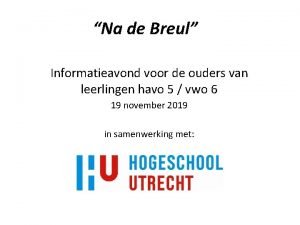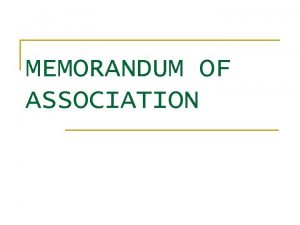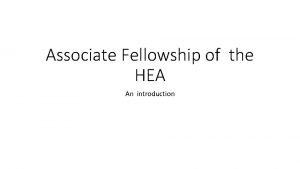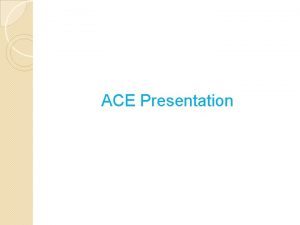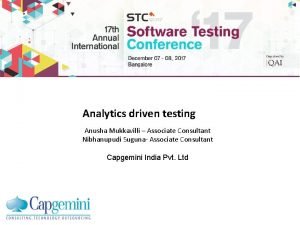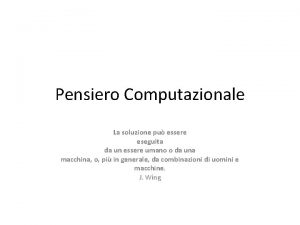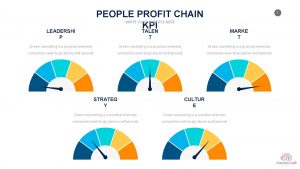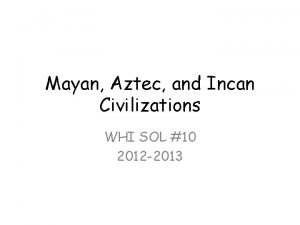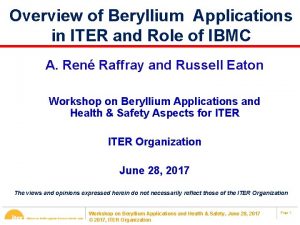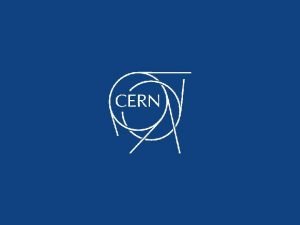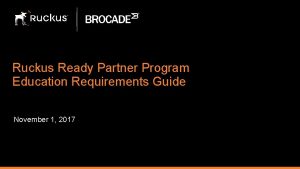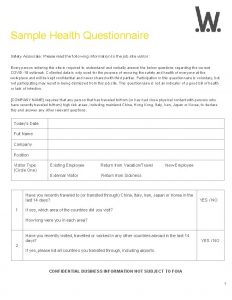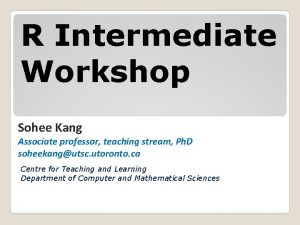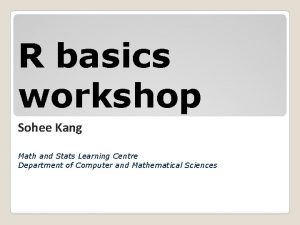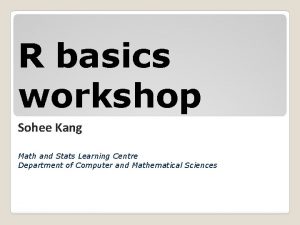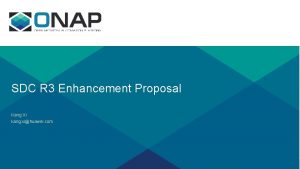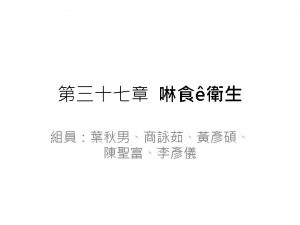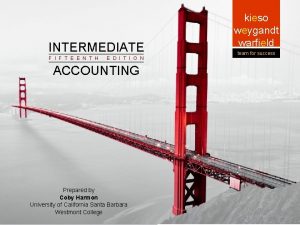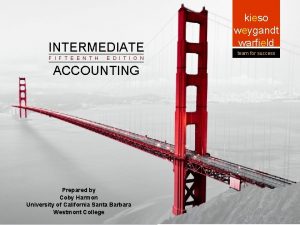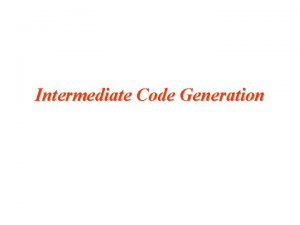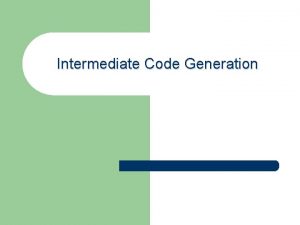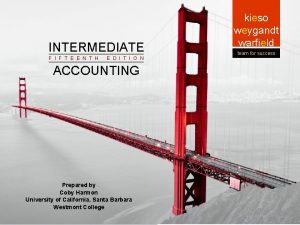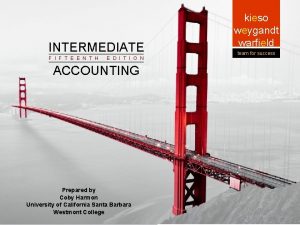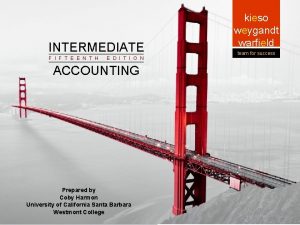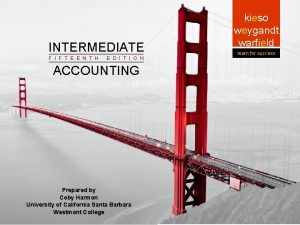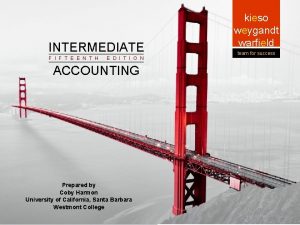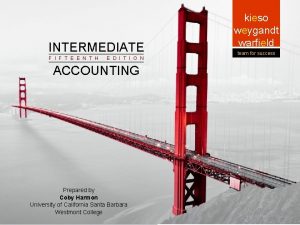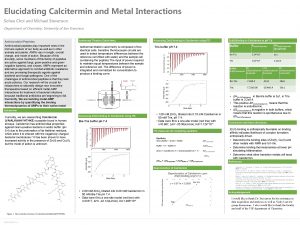R Intermediate Workshop Sohee Kang Associate professor teaching
































- Slides: 32

R Intermediate Workshop Sohee Kang Associate professor, teaching stream, Ph. D soheekang@utsc. utoronto. ca Centre for Teaching and Learning Department of Computer and Mathematical Sciences

Introductions • Link to slides: • Sohee Kang - Ph. D in Biostatistics - Use R to analyze data and teach • who are you? - What are you working on? - Have you used R before? - How do you plan to use R?

Workshop Objective & Topics • Objective: present a way of working with data in R - Basics tools for Data Science • Topics - Data Manipulation: organize/transform/summarize/combine - Data Visualization: language for describing/creating plots

Why R? Many tools STATA, SPSS, Matlab, Excel… Advantages � powerful � up to date with latest algorithms � strong community of users � Preferred by statistics community � Easy to document/modify/reproduce/ share your work � it’s free Disadvantages � steep learning curve, but can be useful quickly � not pretty � can be memory intensive

R Resources • Learning R ü Hands-On Programming with R, by G. Grolemund; excellent beginner introduction to R ü R for Data Science, by H. Wickham and G. Grolemund; what we'll cover today ü Advanced R, by H. Wickham; the gory details (for serious programmers) ü R Cheatsheets; for various tools/libraries

R Overview • R philosophy − Information is contained in objects (e. g. data, variables, models, plots) − Operations are represented by functions (e. g. sort data, fit model, plot results) • R comes with standard functions, but can significantly expand its functionality using packages (a. k. a. libraries) − Packages are bundles of reusable code (functions & data) − Must be downloaded once w/ install. packages() and loaded at start of R session w/ library() install. packages("tidyverse") library(tidyverse) help(package = "tidyverse")

Tidy Data stored in tidy data-frame/table

Workshop Data Toronto Dinesafe program − Every food-serving establishment receives 1 -3+ inspections/year − Public Health Inspector assigns one of 3 types of notice: Available through City of Toronto's Open Data

Complete TASKS in PART 1: First look at data

Reshaping Data Tidying-up data w/ spread()/gather()

Reshaping Data • Split/combine variables w/separate()/unite() 1: 3, • Sort data w/arrange()

Subsetting Data • Pick data frame obs. /variables (i. e. rows/columns)

Transforming Data • Create new variables and summaries

Pipes • Pipe operator %>% passes object as function's (first) argument x %>% f(y) = f(x, y) or y %>% f(x, . ) = f(x, y) • Apply functions sequentially data %>% filter( ) %>% select( ) %>% summarize Identical but much easier to read than summarize( select( filter(data) )

Grouping • Apply summary functions to groups (i. e. subsets of data) X %>% group_by(v 2) %>% summarise(M=mean(v 1)) Can group on multiple variables - Each summary function removes last group level

Complete TASKS in PART 2: Manipulating data

Combining Data • Joins merge data-frames by common values

Combining Data • More Joins

Combining Data • Filtering Joins

Combining Data • Set operations on rows (observations)

Combining Data • Attaching rows/columns

Complete TASKS in PART 3: Combining data

Data Visualization • • • Communicate information from data through graphs (plots, charts, maps, etc. ) Need conventions for communicating graphical information, i. e. a Grammar of Graphics We will use the ggplot 2 package in R to think about, describe, and create

Graph Anatomy • Graphs are created from the same components: − Data − Geometric objects (lines, points, text, etc) − Coordinate systems − Other annotations (labels, legends, etc) • Multiple geometric objects are overlayed on a single coordinate system to create a graph

Aesthetic Mappings • Geometric objects convey information through their aesthetics • Variable in the data can be mapped to one or more of these aesthetics • Most common aesthetic mappings ⁻ Location: x, y (coordinates) ⁻ Appearance: size, color, fill

Plotting in ggplot 2 • Using proper grammar w/ ggplot() + layers ggplot(data = dinesafe) + geom_bar(aes(x=MINIMUM_INSPECTIONS_PERYEAR))

Data Tranformations • Data can be transformed for plotting through stat function ggplot(data = dinesafe, aes(x=SEVERITY, y=AMOUNT_FINED)) + stat_summary(fun. y = "sum", geom="bar")

Faceting • Create grid of sub-plots, one for each level of a variable ggplot(data = dinesafe, aes(x=SEVERITY, y=AMOUNT_FINED)) + stat_summary(fun. y = "sum", geom="bar") + facet_wrap( facets = ~MINIMUM_INSPECTIONS_PERYEAR)

Plot Adjustments • Other aspects for fine-tuning plots ⁻ Coordinates: cartesian, polar, flipped, maps ⁻ Scales: control range of aesthetic values ⁻ Annotations: axis labels, legends ⁻ Positional Adjustments: arranging multiple geoms

Complete TASKS in PART 4: Data Visualisation

Wrap-up • What you learned: - Organize, manipulate & visualise data in R • Follow-up: ⁻ Use recommended resources ⁻ Take a course (online or physical) ⁻ Practice R/Rstudio on your own • Next steps: ⁻ Perform basic statistical analyses ⁻ Write reproducible reports with Rmarkdown

Acknowledgements • Many thanks to the entire R community for making such an amazing tool available and accessible to everyone • Special thanks to Hadley Wickham, for revolutionizing R • Thank you for you attention!
 Promotion from assistant to associate professor
Promotion from assistant to associate professor Microteaching meaning
Microteaching meaning Kosten tio hbo
Kosten tio hbo Memorandum of association
Memorandum of association Associate warden
Associate warden Incose certification
Incose certification My sis harbor college
My sis harbor college Child development program director permit
Child development program director permit Hea associate fellowship
Hea associate fellowship Laser alignment
Laser alignment Associate consultant in capgemini
Associate consultant in capgemini Adobe certified associate certification programs
Adobe certified associate certification programs Tecniche associate al pensiero computazionale
Tecniche associate al pensiero computazionale Harper college associate degrees
Harper college associate degrees What is an associate director
What is an associate director Marine corps league associate member uniform
Marine corps league associate member uniform Associate degree startdag
Associate degree startdag What is the advantage and disadvantage for direct mapping?
What is the advantage and disadvantage for direct mapping? Words or phrases that associate with critical reading
Words or phrases that associate with critical reading Jeannie watkins
Jeannie watkins Mhp associate partner gehalt
Mhp associate partner gehalt Cincinnati state associate degrees
Cincinnati state associate degrees What does this drawing indicate about the inca civilization
What does this drawing indicate about the inca civilization Iter project associate
Iter project associate Cipd self-assessment examples
Cipd self-assessment examples Cern pjas
Cern pjas Associate consultant in capgemini
Associate consultant in capgemini Imeche associate membership
Imeche associate membership برنامهxx
برنامهxx Stratog online lectures
Stratog online lectures Ruckus accredited partner
Ruckus accredited partner Safety associate
Safety associate Lonestar nursing program
Lonestar nursing program


